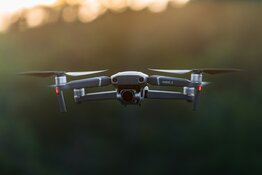DroneShield Ltd. (DRO:ASX; DRSHF:OTC) announced the launch of SentryCiv, a subscription-based, artificial intelligence-enabled counterdrone system developed for civilian use. The company described the technology as a passive, cost-effective layer of airspace security aimed at protecting high-risk, non-military sites such as airports, utilities, data centers, venues, government facilities, energy infrastructure, power grids, correctional institutions, and corporate campuses.
SentryCiv integrates with DroneShield's Sentry-C2 Civ command-and-control platform, offering operators real-time alerts, threat prioritization, customizable zones, and integration with third-party systems. The solution employs the company's proprietary DroneLocator technology to track both drones and operators, extending beyond RemoteID requirements. It uses an encrypted radio-frequency threat detection engine, RFAI™, to identify a wide range of common drone models without disrupting other communications systems.
According to Chief Executive Officer Oleg Vornik in the news release, "As drone threats continue to proliferate worldwide, critical infrastructure is increasingly vulnerable to malicious and unauthorized drone activity. SentryCiv offers a comprehensive, scalable solution that provides real-time detection, and situational awareness. This next-gen technology is engineered to seamlessly integrate into existing security frameworks, enabling a rapid response to potential threats without disrupting operations." Tom Adams, Director of Public Safety at DroneShield, stated that the product "represents our commitment to making advanced counter-drone solutions accessible and affordable for non-military sectors."
SentryCiv operates on a software-as-a-service (SaaS) model with no upfront purchase cost. DroneShield plans quarterly software updates to expand detection capabilities, improve performance, and introduce new features. The company indicated that while it cannot quantify expected sales at this time, demand from the civilian sector is anticipated to be significant, with further guidance to be provided when available.
Advancements in Private and Counter-Drone Technology
Artificial intelligence is playing an increasingly important role in private drone capabilities. Stratview Research reported on June 24 that the AI in drones market was valued at US$12.8 billion in 2024 and was forecast to grow to US$55 billion by 2032, a 19.4% CAGR. Delivery and logistics, as well as surveillance and monitoring, were identified as leading applications in the private domain, with AI enabling real-time analytics, route optimization, and automated operations. Cloud-based drones were cited as having the highest growth potential in commercial use due to scalability and the ability to process data instantly for applications such as infrastructure inspection, environmental monitoring, and smart city management.
Hardware advances — including lighter airframes, AI-enabled chips, and improved obstacle avoidance — have broadened adoption in sectors like agriculture, where drones are used for precision spraying and crop health assessments, and in construction, where they support surveying and progress tracking.
Daniel Laing of Bell Potter Securities also upgraded DroneShield's rating to Buy from Hold following the release of its Q2/25 and H1/25 results.
According to the Global Drone Market Outlook from Grand View Research on July 21, the consumer segment, which includes hobbyist and recreational drones, was valued at roughly US$4.8 billion in 2023 and was projected to reach US$11.6 billion by 2030, reflecting a compound annual growth rate of about 13.3%.
Commercial drones, used across industries such as construction, agriculture, energy, real estate, and media, accounted for an estimated US$30 billion in 2024, with forecasts suggesting growth to around US$55 billion by 2030 at a rate of approximately 10.6% annually. While consumer drones remain smaller in market value, commercial applications dominate the private sector’s revenue and continue to expand as enterprises adopt drones for efficiency, safety, and data collection.
The Counter-UAS Challenge article published on August 5 stated that the ability to locate and address drones operating in unauthorized areas was described by the U.S. Department of Homeland Security as "vital to maintaining secure borders and protecting assets." Lockheed Martin's Counter-UAS Director Tyler Griffin emphasized the need for "diverse, integrated sensors that can track dozens of small, low-flying drones, layered effectors capable of progressively thinning the swarm, and an intelligent battle management system" to match threats to effectors under severe time constraints.
On August 9, Army Recognition reported on advancements to the U.S. Army's Armored Multi-Purpose Vehicle program, which included capability kits for counter-unmanned aerial systems detection and targeting. Bill Sheehy, Ground Maneuver product line director for BAE Systems, said the program was "a proving ground for the future of tracked ground combat" and highlighted the integration of counter-UAS technologies as part of its mission adaptability.
An August 10 article by Stavros Atlamazoglou on NationalInterest.org detailed comments from Army Lt. Gen. Robert Rasch, director of the U.S. Army's Rapid Capabilities and Critical Technologies Office, who said, "We have to continue to work harder, we have to continue to work with the soldiers. We have to continue to work with industry to develop our directed-energy platforms and focus on the areas of reliability." The article reported that the Army had developed 17 directed energy weapon prototypes, deploying 11 mainly to the Middle East, with the systems ranging from 10 to 300 kilowatts. Directed energy weapons were described as offering a relatively low cost per shot compared to conventional interceptor missiles, while providing the ability to counter a variety of aerial threats, including unmanned systems.
Analysts Raise Targets on Strong Results
According to a July 30 research note from Abraham Akra of Shaw and Partners, DroneShield's Q2/25 results showed that "revenue acceleration is now translating into free cash flow generation." The firm upgraded its recommendation to Buy from Hold and raised its target price by 80% to AU$3.60 per share. Akra highlighted that the company had "pivoted from capex and inventory buildout to cash generative," supported by operating scale, a capital-light balance sheet, and full-year 2025 revenue visibility of AU$176 million. He reported net operating cash of AU$13.4 million for the quarter, bringing liquidity to about AU$204 million with no debt, and noted that strong gross margins enabled the company to fund growth organically while retaining mergers and acquisitions flexibility. Akra also cited a sales pipeline of AU$2.33 billion with 284 active opportunities, including 13 deals worth more than AU$30 million, and pointed to the company's expanded manufacturing capacity and inventory position as factors supporting rapid order fulfillment.
In a separate July 30 research note, Daniel Laing of Bell Potter Securities also upgraded DroneShield's rating to Buy from Hold following the release of its Q2/25 and H1/25 results. Laing wrote that "DRO's strong H1/25 results (unaudited), high-level of contracted revenue (AU$176.3M) and recent share price pullback provides us with increased confidence in its near-term outlook." Bell Potter maintained its AU$3.80 per share 12-month price target, representing a 20% implied return from the trading price at the time of the report. Laing reported that Q2/25 revenue was AU$38.8 million, up 480% year over year, and that H1/25 revenue reached AU$72.3 million, exceeding forecasts. He also noted that the company ended Q2/25 with AU$192 million in cash and a robust AU$2.3 billion sales pipeline, with significant opportunities in Europe and the U.S. Laing concluded that DroneShield was "well-positioned to continue its strong performance," supported by scaled operations, healthy inventory, and demand driven by structural growth in the counterdrone market.
Expanding Civilian Market Footprint
The introduction of SentryCiv aligns with DroneShield's strategic goal of expanding its presence in the civilian security market. As outlined in its July 2025 investor presentation, the company has been increasing its focus on non-military sectors as part of a broader diversification strategy, underpinned by rising demand for counter-uncrewed aerial system (C-UxS) technology in both defence and civilian markets.
 Streetwise Ownership Overview*
Streetwise Ownership Overview*
DroneShield Ltd. (DRO:ASX; DRSHF:OTC)
DroneShield reported HY2025 revenue of AU$72.3 million, up 210% compared to the prior year, with SaaS revenue rising 177% over the same period. The company's sales pipeline as of July 2025 stood at AU$2.33 billion, representing a 112% increase from the previous year, with projects spanning multiple geographies and sectors.
Management has indicated that the civilian market expansion, supported by products like SentryCiv, forms part of its plan to grow SaaS revenues, increase gross margins, and establish regional manufacturing hubs to serve global customers.
Ownership and Share Structure
Recent filings reveal that Vanguard Group has become a substantial shareholder in DroneShield, holding a 5.45% stake and Fidelity Management and Research holds approximately 9.59%.
Management and insiders hold 1.34%, according to the most recent company presentation.
DroneShield has 874.61 million outstanding shares and 862.8 million free float traded shares. Its market cap is approximately AU$3.7 billion, and its sales pipeline has grown to AU$2.33 billion. The company's 52-week share price range is AU$0.5850 to AU$4.39.
| Want to be the first to know about interesting Technology investment ideas? Sign up to receive the FREE Streetwise Reports' newsletter. | Subscribe |
Important Disclosures:
- As of the date of this article, officers and/or employees of Streetwise Reports LLC (including members of their household) own securities of DroneShield Ltd.
- James Guttman wrote this article for Streetwise Reports LLC and provides services to Streetwise Reports as an employee.
- This article does not constitute investment advice and is not a solicitation for any investment. Streetwise Reports does not render general or specific investment advice and the information on Streetwise Reports should not be considered a recommendation to buy or sell any security. Each reader is encouraged to consult with his or her personal financial adviser and perform their own comprehensive investment research. By opening this page, each reader accepts and agrees to Streetwise Reports' terms of use and full legal disclaimer. Streetwise Reports does not endorse or recommend the business, products, services or securities of any company.
For additional disclosures, please click here.








































